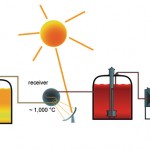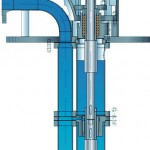Owing to their high heat capacity and thermal conductivity, molten salts are used today in the chemical industry to transfer heat and in power stations for heat storage. In solar thermal power stations, for example, the thermal energy collected by mirrors is stored in molten salts. In a secondary circuit, the steam produced with this energy then drives a steam turbine with a generator.
In the space of just six hours, our Earth receives enough solar energy to cover the global energy requirement for a whole year. Solar thermal power stations utilise this solar radiation to generate electricity. The technically usable potential of solar thermal electricity generation is many times greater than worldwide electricity consumption. Unlike photovoltaic, solar thermal power stations as planned today can produce electricity in the range from 50 to 250 MW. If a thermal storage reservoir (preferably using molten salts) is integrated as well, electricity can be generated even after the sun goes down and provided in a planned manner.
“Solar thermal power station” is a general term covering a variety of technologies. A distinction is made between concentrating systems, such as parabolic trough, Fresnel and tower power stations or solar dishes, which gather the sunlight using mirrors, and non-concentrating plant. In concentrating systems the thermal energy extracted is delivered, usually to a steam circuit, at temperatures well above 100 °C. The steam is then utilised in a turbine to generate electricity. Non-concentrating systems do not use mirrors. Solar updraft power stations are a good example of this type of technology.
Good eco-balance
Solar thermal power stations have a very good eco-balance. The energy recovery time of five months is low – even in comparison to other regenerative energies. Among CSP (Concentrated Solar Power) technologies, the parabolic trough has the lowest material requirement and moreover a much smaller footprint than biomass, wind energy or hydroelectric power – apart from the retaining dams in the high mountains. As these are erected exclusively in the Earth’s dry zones, there is hardly any competition for land use. Solar thermal power stations can be built in the Earth’s Sun Belt between a latitude of 35° either side of the Equator.
In parabolic trough concentrator power stations, the sunlight is concentrated by means of mirror arrangements. At the focal spot or on the focal line is a radiation collector, known as the receiver, which heats up the fluid (molten salts or heat transfer oil) in a primary circuit. In a secondary circuit, the steam produced with this energy then drives a steam turbine with a generator. To guarantee a constant electricity supply, individual power stations need intermediate heat storage to tide them over the night. The excellent heat storage capacity of salt offers an effective solution that can substantially increase the plant’s efficiency.
In solar tower power stations, the solar radiation is focused on a tower by a large array of individually tracking plane mirrors, known as heliostats. A receiver installed there absorbs the radiant energy and delivers it to a heat transfer medium. The remainder of the process is similar to the parabolic trough system.
Resistance to high temperatures
Molten salts have been used for many years, especially in industrial scale chemical plants, to transfer and store heat in the temperature range between 180 and 450 °C. In specific applications, the temperatures can even reach 560 °C. The manufacture of pumps for high-temperature applications requires a high level of coordination between the design engineering, materials and intelligent plant technology.
One of these new solar thermal power stations, which goes by the name of the Archimedes Project, is currently being built as a demonstration plant in Sicily/Italy. The project was undertaken by a consortium consisting of the Italian Energy Corporation ENEL and ENEA, the Italian National Research and Development Institute for New Technologies, Energy and the Environment. In March 2007, ENEL and ENEA signed a contract for the construction of the Archimedes demonstration plant in Priolo Gargallo. The start of energy production was planned for the end of 2009. According to the planning specification, the plant can generate 56 MW of solar electricity, corresponding to a saving of about 7300 t of CO2 compared to conventional power stations.
In July 2007, Friatec AG’s Rheinhütte Pumps Division received the order for the supply of six vertical pumps up to 8 m long for pumping molten salts at 550 °C. Due to the re-engineered technology with its special, medium-lubricated sleeve bearing concept together with the use of high-grade stainless steels, the GVSO type vertical submersible pump is best suited for high-temperature applications of this kind. With 20 model sizes with up to five stages, delivery rates up to 2000 m³/h and submersion depths down to 17,000 mm, this pump type offers maximum planning flexibility. On request, the Rheinhütte Pumps Division can also supply the 450/500 model for up to 3000 m³/h.
The vertical pump is manufactured as a single or multi-stage model for pumping chemically aggressive, hot and contaminated fluids, molten materials and liquefied gases. The pumping temperature of the media is between –160 and +550 °C. The pump provides further benefits due to the unique, medium-lubricated sleeve bearing concept, which is specially designed and matched to the medium and requirements (e.g. external lubrication). It is additionally characterised by a very service-friendly design. One important cost and time saving benefit is that after reaching the end of its nominal life, the rolling contact bearing can be replaced on site thanks to the separate bearing housing. Another advantage is that the delivery flange is extended beyond the sole plate, allowing the pump to be removed without dismantling the delivery pipe.
Online-Info www.cpp-net.com/2110448

According to the forecasts of the International Energy Agency (IEA) the global energy requirement will increase by more than 50% by 2030. This development means further risks to the security of supplies and to the environment and also rising energy prices. In more and more countries the interest in renewable energy is thus increasing. Solar thermal power stations are mostly designed for the central generation of electricity and are thus predominantly large scale plants with an output from 50 to 250 MW, operating in the high temperature range (400 to 800 °C).
The first of the latest generation of solar power stations have gone into the electricity grid in the last two years in the USA and Spain, the commissioning of the Archimedes test plant in Italy is due shortly, detailed technical discussions about further definite projects are taking place at the moment in the USA, Spain and Australia. If the technology proves itself and if the investment cost for the overall systems can be reduced further, then solar electricity has the potential in the medium and long term to replace fossil fuelled power stations.
The „Desertec Project – Solar electricity from the Sahara“ is another large ambitious step to supply Europe with some of its solar electricity from the desert.
Share:











